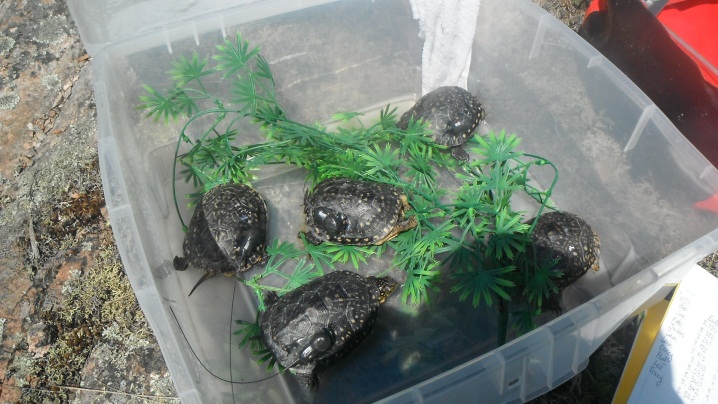The Kawartha Turtle Trauma Centre (KTTC) launched in 2002 with the mission is to aid in the conservation of Ontario’s turtles. This is accomplished through a three-pronged approach to conservation that includes rehabilitation, field research and education. The KTTC hospital admits upwards of 500 injured adult turtles per year. They include all Ontario’s turtle species, but the majority are Blanding’s Turtles, Painted Turtles, Snapping Turtles and Map Turtles. They are treated, rehabilitated and released near where they were found. Many of the turtles are gravid (egg-bearing) and a head-starting project has evolved as an extension of the hospital. Approximately 2000 eggs were collected and incubated in 2014, from injured or even deceased turtles. They are released either after hatching, or after overwintering, near where the mother was found. Most of the care of the turtles housed at KTTC is carried out by volunteers who clean, feed and care for the turtles year round. In addition, volunteers bring the turtles to the hospital initially, and release them once healed.
KTTC’s field research came about as a natural extension of the head-starting program. There is a lack of knowledge in the literature about the ‘success’ of head-starting as a conservation strategy. Not only does KTTC aim to add to the knowledge of whether head-started turtles contribute sufficiently to recruitment into the adult population to justify the resources put into it, but KTTC also aims to add to knowledge of best practices for head-starting. For example, it is critical to know when, how and where to release young turtles. With funding from such organizations as Great Lakes Guardian Community Fund, Wildlife Preservation Canada, and Species at Risk Stewardship Fund, KTTC is attempting to answer some of these questions. In addition to radio tracking a large number of head-started Blanding’s Turtles, a comparable group of wild juveniles and adults are also being followed. This is allows comparison between the head-started turtles’ behaviour and survival to that of wild counterparts, and also helps to delineate the differences between adult and juvenile behaviour and movements. This research enables improvements to protocols which leads to increased survival. KTTC also conducts population surveys of Blanding’s Turtles and Spotted Turtles in previously un-surveyed areas, road mortality surveys to identify ideal sites for ecopassage implementation, and collaborates with road ecology groups to construct and monitor ecopassages.

Figure 1. Head start Blanding’s Turtles ready for release with transmitters (credit: Sue Carstairs).
Figure 1. Head start Blanding’s Turtles ready for release with transmitters (credit: Sue Carstairs).
